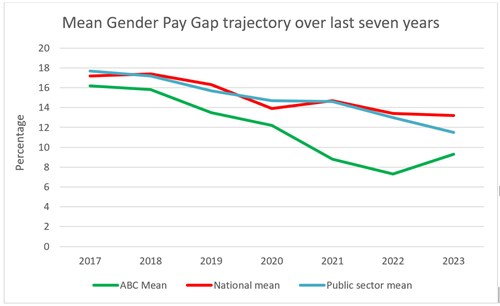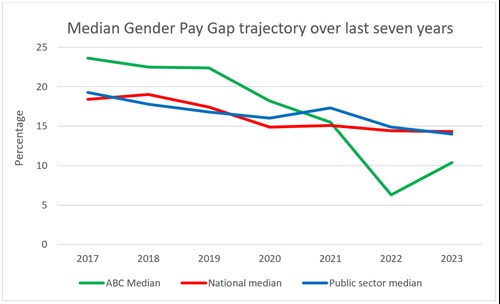Gender Pay Gap Statistics - March 2023
We continue to welcome the Government’s requirement for large organisations to be more transparent on gender pay, and will use this opportunity to nurture our culture of supporting women in the workplace, ensuring success is defined by talent, not gender or circumstance.
What is a gender pay gap?
A gender pay gap is the difference in average pay between the men and women in a workforce, expressed relative to men’s earnings. For example, ‘women earn 15% less than men per hour’.
It is different to equal pay, which is a legal requirement to pay men and women the same for equal or similar work. Ashford Borough Council has a robust job evaluation system which ensures equality of pay.
Having a gender pay gap does not mean that unlawful discrimination is occurring. The majority of organisations will have a gap for varying reasons, some of which are due to much broader influences such as economic, cultural, societal and educational factors.
Ashford Borough Council Data as at 31 March 2023
The calculations are taken from the March 2023 payroll as a snapshot of anyone who was employed as at 31 March 2023. Both our mean and median gap have increased slightly.
Mean (average) gender pay gap in hourly pay: 9.3%
Median (mid-point) gender pay gap in hourly pay: 10.4%
| Pay quartile | Men % | Women % |
|---|---|---|
| Top | 53.8 | 46.2 |
| Upper middle | 34.6 | 65.4 |
| Lower middle | 34.6 | 65.4 |
| Lower | 37.7 | 62.3 |


Mean (average) bonus gender pay gap: 41.3%
Median (mid-point) bonus gender pay gap: -1,567%
Proportion of males and females receiving a bonus payment: Males (14.4%), Females (0.9%)
We do not operate a bonus or performance related pay scheme. We calculate our figures according to the gender pay gap legislation using:
- long service awards (two females this year) and long service awards on retirement (none relevant to this year)
- an informal non-contractual operational arrangement for the provision of a voucher reward scheme at Aspire, the council’s landscape management team (twenty nine males and one female)
- honorariums specific to exceptional performance (none this year)
- enhanced recruitment pay (two males)
The statistics look unusual because more men than women received a ‘bonus payment’, and were paid more on average but women were paid more at mid-point.
This reflects the fact that the rewards at Aspire were given at varying small amounts to a mainly male workforce and there were two larger male payments for enhanced recruitment pay, whereas there were no female payments for enhanced recruitment pay during that twelve month period but two long service payments. This is the second year that we have given enhanced recruitment pay hence the large difference in the median calculation to previous years.
What do our calculations mean?
There has been a small increase in our gender pay gap figures as our workforce fluctuates but we have no big concerns and we will continue to ensure women have the same opportunities as men to fulfil their potential in the workplace. Our pay structure, policies, recruitment procedures and training programme are set without bias to gender or any other personal characteristic. Policies and procedures assist both our male and female staff in a work-life balance and career progression opportunities.
We are committed to having a diverse and inclusive workplace that gives equal opportunities to all employees irrespective of gender.
Actions
Examples of the type of work that we will continue to expand on to assist in closing our gap in the coming years will include:
- Providing interview training for recruiting managers including removing subconscious bias
- Emphasising the value of one to ones and Personal Development Plans
- Speaking to young people at careers fairs using female case studies
- Ensuring training is local where possible
- Highlighting the importance of a work life balance
- Using e-learning, SDI training and competency spotlights to recognise our differences, nurture acceptable and eliminate unacceptable behaviour
- Embedding our flexible working and remote working policies and discussing these at interview stage
- Looking at secondment opportunities and flexible ways of recruiting to a post
- Removing current salary details from application form to counter subconscious bias
- Introducing peer support groups (for example for working parents and elder care)
- Putting relevant policies on our website for job seekers to view so they can see our flexible ways of working
- Continuing to support flexible working applications from both men and women to destigmatise men working part time and give all genders opportunity for flexibility where possible






